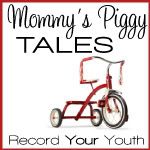Many of my most vivid memories relate to food. I loved all the family gatherings when I was a kid. With six brothers and sisters, grandparents, aunts, uncles and cousins all living in a relatively small area, we seemed to get together every week. If the occasion was not for a complete meal, then there had to be “lunch” served with coffee and a variety of scrumptious sweets. I dearly loved sitting quietly nearby so I could hear everyone talk and tell their stories.
To this day, I can’t see or smell cinnamon rolls without thinking of Mom and all her delicious baked goods. Grandma always kept a clear glass container like a huge brandy snifter in the center of her table, filled to the brim with several kinds of homemade cookies. Whenever she felt we didn’t eat the cookies quickly enough, she topped all of them with chocolate icing.
Connected with those fabulous food memories are the memorable family stories that were told and retold. I never tired of hearing favorite stories from bygone days. Food is one great way to open up a treasure chest of memories.
1. Get the stories behind the food
What do you think of when asked about your favorite food? Is it something that your grandmother made, like apple crisp? Or is it your Uncle Pete’s awesome barbecued ribs? Or how about your neighbor’s chocolate fudge? Or is it something you make yourself, like a peanut butter, jelly and banana sandwich? One of my own family favorites is fresh lemon meringue pie, which Mom made better than anyone else.
Whatever it is, everyone has favorite foods. Many of these foods make us think of when we were younger. But did you ever wonder about the stories behind the food? Who came up with the original recipe for apple crisp? And who on earth decided to add raisins or nuts to it? You can get some wonderful stories when you ask the cooks questions like these.
2. Use the power of food to recall memories
Food can be a powerful trigger to help you recall memories. If someone mentions pumpkin pie, do you think of Thanksgiving dinner? Do gingerbread cookies remind you of Christmas? Do hard-boiled eggs lead to thoughts of Easter? Whenever I see pecan pie, I always think about shelling pecans by the bushel (it sure seemed like a bushel, anyway) so we’d have pecans all winter.
You can use food to remind your family circle of stories you want to hear. One idea is to throw a cookie baking party. Everyone has fun, you get to make cookies (or pizza, or pretzels, or whatever you like best) and you dig up stories from the past. Best of all, you get to enjoy your favorite foods and favorite people at the same time.
Whenever people get together, they like to talk and tell stories. You will have a chance to ask questions like the ones at the end of this book. And you can make up your own questions, too. Just remember to either write down what people say or use a recorder to capture it. That’s a whole lot easier than trying to remember all the details later.
3. Use family gatherings for more story-telling
Any gathering of your friends and family is a great chance to capture more stories. Many times, this is a fun opportunity for group discussions. Getting people to talk about their favorite foods will always lead to good memories. Ask about the first time Aunt Alice made a favorite recipe like macaroni and cheese and burned it. Where did she learn how to fix it? Some families may have their own idea of what a dish should be like. For example, one family may like macaroni and cheese from the blue box, but another family might be disappointed if they didn’t get it homemade from scratch with three kinds of cheese. They’re all keys to opening up those memories.
4. Combine family stories and recipes
One way to capture family stories and recipes is to make a little cookbook of your favorite foods. Then you can add stories to go along with the recipes. It is fun to show the original recipe and who made it. Then show any changes that other people made to it.
To get stories from your family circle, you can ask each of them to write down their favorite recipe onto a card. Make sure they include the directions as well. On the other side of the recipe card, ask them to write a few notes about where the original recipe came from. They might also like to give you a photo of the food or the original cook.
Subscribe to:
Post Comments (Atom)





1 comment:
You have some great guidelines here! Some family recipes are difficult to duplicate, but fun nevertheless. Here is an example of my mother's famous peanut brittle recipe, scribbled on a little notepad.
http://elyfamilyblog.blogspot.com/2009/02/marge-elys-peanut-brittle.html
Post a Comment